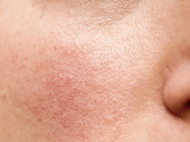ABOUT CYPROSKIN
CYPROSKIN – Preventive care for dry, sensitive and irritated skin for the treatment of oncological diseases, atopic dermatitis, and diabetic skin disorders.
SYMPTOMS:

Dry skin (xerosis cutis)
From a clinical perspective, significant functional deficit of the skin organ expresses via the symptom “dry skin”. Due to the non-specific anti-proliferative effect of an oncological treatment, there are often impairments of the normal proliferation and differentiation of the so-called keratinocytes and thus lead to an interference of the skin’s barrier function. This development is connected to increased transepidermal water loss (TEWL) and an increasing deficit of skin lipids (e.g. ceramide). This is expressed as dry, flaky skin, itching and irritative inflammations.

Acneform skin exanthema (papulopustular exanthema)
The epithelial growth factor (EGF) is one of the central factors for the development and regeneration of epithelial tissue and thus the epidermis. Due to the distribution of the EGF receptors (CEGFR), in particular on the follicle structures and in the basal epidermal layer, the significance of the epidermal stem cells in the regulation processes of the skin becomes apparent. The assumption is that a treatment-related inhibition of the EGF receptors causes interference with the signals transferred through the receptors. The normal proliferation and differentiation of the keratinocytes is thus interfered with and inflammatory processes form. These express as dry skin (xerosis) and acne-like exanthemae.

Hand-foot syndrome (palmoplantar erythrodysesthesia)
The so-called hand-foot syndrome is an undesired dermal side effect on the plantar and palmar skin on the palms and soles of the feet. Scientific research has proven that certain therapeutic agents and their metabolites are excreted via the sweat. When in contact with oxygen, so-called free radicals form. Due to the density of sweat glands on the palms of the hands and the soles of the feet and the thickness of the corny layer on the palmar and plantar skin, there is an increased intake and enrichment of metabolites and free radicals. These trigger a complex inflammation process in the skin which can lead to blistering on the palms and soles of the feet due to apoptosis and massive oedemisation.


 EST
EST


